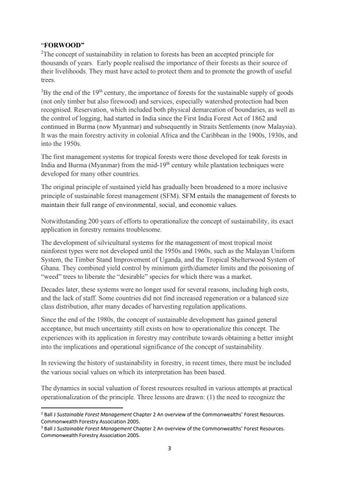“FORWOOD” 2 The concept of sustainability in relation to forests has been an accepted principle for thousands of years. Early people realised the importance of their forests as their source of their livelihoods. They must have acted to protect them and to promote the growth of useful trees. 3
By the end of the 19th century, the importance of forests for the sustainable supply of goods (not only timber but also firewood) and services, especially watershed protection had been recognised. Reservation, which included both physical demarcation of boundaries, as well as the control of logging, had started in India since the First India Forest Act of 1862 and continued in Burma (now Myanmar) and subsequently in Straits Settlements (now Malaysia). It was the main forestry activity in colonial Africa and the Caribbean in the 1900s, 1930s, and into the 1950s. The first management systems for tropical forests were those developed for teak forests in India and Burma (Myanmar) from the mid-19th century while plantation techniques were developed for many other countries. The original principle of sustained yield has gradually been broadened to a more inclusive principle of sustainable forest management (SFM). SFM entails the management of forests to maintain their full range of environmental, social, and economic values. Notwithstanding 200 years of efforts to operationalize the concept of sustainability, its exact application in forestry remains troublesome. The development of silvicultural systems for the management of most tropical moist rainforest types were not developed until the 1950s and 1960s, such as the Malayan Uniform System, the Timber Stand Improvement of Uganda, and the Tropical Shelterwood System of Ghana. They combined yield control by minimum girth/diameter limits and the poisoning of “weed” trees to liberate the “desirable” species for which there was a market. Decades later, these systems were no longer used for several reasons, including high costs, and the lack of staff. Some countries did not find increased regeneration or a balanced size class distribution, after many decades of harvesting regulation applications. Since the end of the 1980s, the concept of sustainable development has gained general acceptance, but much uncertainty still exists on how to operationalize this concept. The experiences with its application in forestry may contribute towards obtaining a better insight into the implications and operational significance of the concept of sustainability. In reviewing the history of sustainability in forestry, in recent times, there must be included the various social values on which its interpretation has been based. The dynamics in social valuation of forest resources resulted in various attempts at practical operationalization of the principle. Three lessons are drawn: (1) the need to recognize the 2
Ball J Sustainable Forest Management Chapter 2 An overview of the Commonwealths’ Forest Resources. Commonwealth Forestry Association 2005. 3 Ball J Sustainable Forest Management Chapter 2 An overview of the Commonwealths’ Forest Resources. Commonwealth Forestry Association 2005.
3









